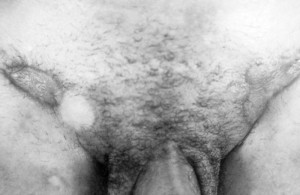This is a chronic, progressive, ulcerative, sexually-transmitted disease, involving the vulva, vagina or cervix.
The initial lesion is a papule which undergoes central necrosis to form a clean, granulomatous, sharply-defined ulcer.

This process continues, with development of multiple, confluent ulcers, which may be painful or painless. The ulcers have a beefy red base which bleeds easily. Pseudobuboes in the groin can be felt.
The diagnosis is confirmed with biopsy of the ulcer, showing Donovan bodies on H&E stain or Giemsa stain.
This condition is rare in the United States, but somewhat more common in the tropical areas of southern Africa, India and New Guinea.
Treatment*
Several antimicrobial regimens have been effective, but only a limited number of controlled trials have been published. Treatment has been shown to halt progression of lesions, and healing typically proceeds inward from the ulcer margins; prolonged therapy is usually required to permit granulation and re-epithelialization of the ulcers. Relapse can occur 6–18 months after apparently effective therapy.
Recommended Regimen
- Azithromycin 1 g orally once per week or 500 mg daily for at least 3 weeks and until all lesions have completely healed
Alternative Regimens
- Doxycycline 100 mg orally twice a day for at least 3 weeks and until all lesions have completely healed
OR - Ciprofloxacin 750 mg orally twice a day for at least 3 weeks and until all lesions have completely healed
OR - Erythromycin base 500 mg orally four times a day for at least 3 weeks and until all lesions have completely healed
OR - Trimethoprim-sulfamethoxazole one double-strength (160 mg/800 mg) tablet orally twice a day for at least 3 weeks and until all lesions have completely healed
The addition of another antibiotic to these regimens can be considered if improvement is not evident within the first few days of therapy. Addition of an aminoglycoside to these regimens is an option (gentamicin 1 mg/kg IV every 8 hours).
Other Management Considerations
Persons should be followed clinically until signs and symptoms have resolved. All persons who receive a diagnosis of granuloma inguinale should be tested for HIV.
Follow-up
Patients should be followed clinically until signs and symptoms resolve.
Management of Sex Partners
Persons who have had sexual contact with a patient who has granuloma inguinale within the 60 days before onset of the patient’s symptoms should be examined and offered therapy. However, the value of empiric therapy in the absence of clinical signs and symptoms has not been established.
Special Considerations
Pregnancy
Doxycycline should be avoided in the second and third trimester of pregnancy because of the risk for discoloration of teeth and bones, but is compatible with breastfeeding. Data suggest that ciprofloxacin presents a low risk to the fetus during pregnancy. Sulfonamides are associated with rare but serious kernicterus in those with G6PD deficiency and should be avoided in third trimester and during breastfeeding. For these reasons, pregnant and lactating women should be treated with a macrolide regimen (erythromycin or azithromycin). The addition of an aminoglycoside (gentamicin 1 mg/kg IV every 8 hours) can be considered if improvement is not evident within the first few days of therapy.
HIV Infection
Persons with both granuloma inguinale and HIV infection should receive the same regimens as those who do not have HIV infection. The addition of an aminoglycoside (gentamicin 1 mg/kg IV every 8 hours) can be considered if improvement is not evident within the first few days of therapy.
*CDC 2015 STD Treatment Guidelines
